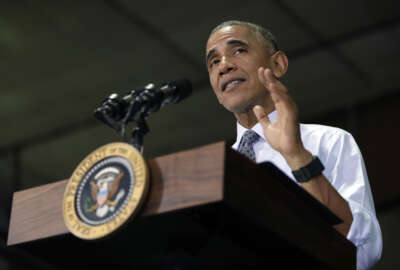
Agencies, industry should expect a lot of ‘churn’ in IT spending
Results of more than 300 interviews of federal technology and acquisition experts for the Professional Services Council’s 2016 Vision conference predicts little...
For the federal IT community, expect fiscal 2017 and beyond to be all about churn.
Like churning butter, federal IT executives and industry experts say between the election, expected slow or non-existent budget growth and uncertainty in leadership, most of the change will happen below the surface.
“With budgets expected to be flat over next several years, requirements growing tremendously and the install base aging rapidly, the combination of all of those things as IT manager or chief information officer, you have to make some tough decisions. You may have to pull money from less important projects and put it on priority initiatives, and that starts the ball rolling when it comes to churn,” said Robert Haas, the team lead for the federal IT budget forecast as part of the Professional Services Council’s 2016 Vision conference. “There are other areas such as shared services that are going to drive contract changes, consolidations and eliminations. There may be additional staff augmentation contracts or program management contracts. The desire and the need to move to more customer-facing types of contracts, or to support a digital enterprise are going to drive the need to have more consultative type of work where you bring business and the IT together, and then work together to solve the problem. That might also eliminate some of the work traditionally done by current vendors in the market under an existing contract.”
Haas said this all comes back to changes in the way agencies are spending their IT budgets.
The idea of churn is one of the major findings coming from PSC’s 52nd annual Vision Market Forecast. Over the last year, 22 study teams made up of industry executives conducted 300 interviews with Defense and civilian agency technology executives as well as acquisition and program managers.
The churn of the federal IT budget just isn’t about what’s happening in the next year, but also how agencies spend the last two months of the Obama administration.
Expect an increase in contract spending over next 2 months
David Berteau, the president and CEO of PSC, said over the last three election cycles, November has been busier than usual in terms of contract spending and January slower than usual.
“We’ve looked at the data of contract obligations in election and inauguration years over the last three cycles and there is a very interesting dynamic there,” he said. “In all three of those cases [2004, 2008 and 2012] in the month of November compared to the average dollar value of contract obligations in November, it skyrocketed. It was like 30 percent higher in November. Why? The people who were trying to finish stuff up were trying to get it out the door. In the month of January, the inauguration time, it plummets. Contract obligations go way below the non-inauguration January average. I put that in the category of churn because you are expecting this January to be like last January and be like next January, and all of sudden, it’s very different.”
Another reason that this idea of churn in the federal IT community will continue is the unknowns about the 2017 budget. Berteau said he expects Congress to pass another continuing resolution that could keep the government open through March.
“We’ve only had two times in the last eight years where the CR went beyond three months,” he said. “The executive branch, the contracting officers and program managers are geared toward the first two or three months we will coast along because we will get a final appropriations in the omnibus at the end of the year. When you get into months five and six of a CR, now you are really squeezing things up and that’s a second source of churn. You will see that much more inside the services side than you will see it inside the products and platform side because that’s where your flexibility is.”
The six-month or even year-long CR also could further impact federal spending on services. Berteau said agencies have increased their spending on services by 2 percent compound growth a year since 2013. But those gains come after agencies cut spending on services by 13 percent between 2010 and 2013, and a year-long CR could mean decreases in this area of spending once again.
Another reason for the churn in 2017 is the real possibility that the Budget Control Act caps coming back in 2018, forcing drastic cuts because of sequestration.
Berteau said because all of these reasons for churn, 2017 and beyond doesn’t bode well for agencies and contractors alike.
Cyber, cloud digital services top priorities for CIOs
There is some good news. Haas said PSC’s research shows the federal IT budget will grow at a larger rate than the community has seen over the last five years. He said PSC predicts a 2.4 percent compound growth rate between 2017 and 2022. Over the previous five years, the federal IT budget grew by only 1.5 percent.
Haas said there are several factors driving that growth, including the focus on digital transformation, better cybersecurity and a shift toward the cloud.
Dave Wennergren, executive vice president of operations and technology for PSC, said the move to the cloud could be the key to let agencies more quickly shift their spending from operations and maintenance (O&M) to development, modernization and enhancement (DME).
“Continuing resolutions make it so you can’t do new starts and when budgets are tight and you are not sure if sequestration will happen, it’s hard to get approval for big capital investments. All of this exacerbates the maintenance of a cycle that says ‘I’ll keep spending my money on sustaining the old because I don’t have to go in with a budget request for a big slug of money to build something new,’” he said. “The hope is some of the CIOs are starting to see this as an opportunity for what I’ll describe as ‘business judo’ where as you move to consumption-based buying you can repurpose the operations and sustainment dollars to buy capacity on demand because you don’t need to do big capital investment if you are going to move to a cloud-based solution.”
Wennergren said mobility and the promise of the Internet of Things and data analytics also are driving spending decisions.
Alan Chvotkin, PSC’s executive vice president and senior counsel, said the concept of “as-a-service” also is impacting acquisition processes. He said agencies want to buy innovation as well as innovate how they are buying.
Rich McFarland, the chairman of the Defense study group, said based on all of the interviews and the election results agencies and industry need to view the next year and beyond differently.
“We are looking at the next administration and particularly Mr. Trump as a disruptor. We look for disruptors in business all the time,” McFarland said. “I think he is a disruptor from a political standpoint, from a governance standpoint and from an economics standpoint. [We] have to understand how my business plan assumptions are going to be tested. I’m going to be looking for opportunities. I’ll be looking for pitfalls. But mainly what is the risk band I’m dealing with for this upcoming year and the next couple of years.”
Copyright © 2025 Federal News Network. All rights reserved. This website is not intended for users located within the European Economic Area.
Jason Miller is executive editor of Federal News Network and directs news coverage on the people, policy and programs of the federal government.
Follow @jmillerWFED
Related Stories

OMB reveals proposed guidance on federal IT modernization




